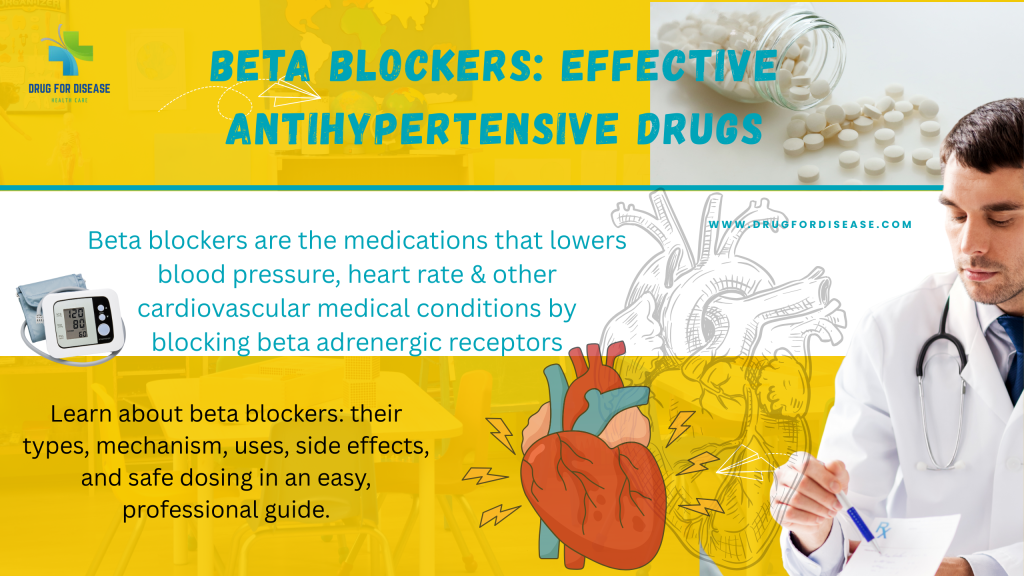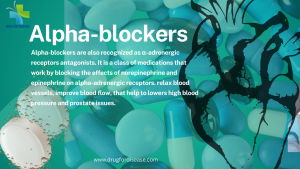Beta Blockers: Effective Antihypertensive Drugs

Beta blockers are also known as β-adrenergic receptor antagonists or blockers. They are effective antihypertensive drugs used to treat hypertension, anxiety, cardiac arrhythmia (irregular heartbeat) and other associated cardiovascular conditions. This document gives a brief information on mechanism of action, therapeutic use, precautions or contraindications and side effects of beta-blockers. Understanding of these aspects will be helpful bot only for healthcare professionals but also for patients to ensure safe and effective utilization of these medications. European Society of Hypertension (ESH) guidelines; Recent (2023) guideline from the European Society of Hypertension (ESH) add β-blockers in the group of effective antihypertensive agents that can be used as first line protocol suitable for initiation of antihypertensive pharmacotherapy. Moreover, can be used in combination with other antihypertensive agents. It is in contrast to the 2018 edition of ESH guidelines. The ESH guideline also recommends the use of β-blockers for patients having resting heart rate (>80 bpm); high resting heart rate is a sign of sympathetic overactivity may lead to the of adverse cardiac remodeling in the setting of hypertension and heart failure. It can be given alone as monotherapy or in combination also. When β-blocker is prescribed, with dihydropyridine calcium channel blocker as combination regimen, these agents reduce both peripheral and central BP. Various studies have shown that the burden of premature morbidity and mortality associated with uncontrolled hypertension, especially strokes can be reduced by combination therapy. What is the Mechanism? Beta-blockers are the competitive antagonist of beta-adrenergic receptors (sympathetic nervous system). they block the action of epinephrine and norepinephrine at beta-adrenergic receptors. These beta-adrenergic receptors are located mainly in the smooth muscles of heart, kidneys, arteries and airways. β1 Receptor Blockade: Blockage of β1 receptors in the heart decrease heart rate, contractility, and cardiac output. It reduces the workload on the heart and normalize blood pressure. these drugs also inhibit the secretion of renin by blocking β1 receptors in the kidneys, a hormone that helps to maintain blood pressure regulation. β2 Receptor Blockade: Bronchoconstriction occurs due to the blocking of β2 receptors cited at the lungs. Avoid the use of non-selective beta-blockers in patients with asthma or chronic obstructive pulmonary disease. some β2 receptors are also situated at blood vessels, and their blockade can lead to vasoconstriction. Classification of Beta Blockers Beta blockers are basically classified according to their activity on adrenergic receptors β1, β2, and β3 receptors, that are as follows: β1 Blockers al; the other name of cardio selective beta blockers. they are mainly found in the heart and kidneys. The most common drugs are metoprolol, atenolol, and bisoprolol. β1 and β2 Blockers also known as non-selective beta blockers as they block the activity of both receptors β1 and β2. Examples are propranolol, nadolol, and timolol. Alpha- and Beta-adrenergic receptor blockers: exert action by blocking both alpha and beta-adrenergic receptors. Examples include labetalol and carvedilol. These drugs are newer and more effective in youngers and lowers high blood pressure that is linked to stress or anxiety. β-Blockers with Intrinsic Sympathomimetic Activity: Few β blockers have Intrinsic sympathomimetic activity (ISA), an activity in which a drug can exhibit both agonist and antagonist properties at a given beta receptor depending on concentration. examples are penbutolol, oxprenolol, pindolol etc. Lipid-soluble beta blockers that can cross blood brain barrier e.g. Propranolol, Metoprolol Water-soluble; that has les CNS effects e.g. Atenolol, Nadolol Indications; Hypertension; Beta-blockers are effective antihypertensive drugs especially in younger patients and those with elevated sympathetic activity. in combination therapy beta blockers reduce both peripheral and central blood pressure. Angina pectoris’ beta-blockers lower myocardial oxygen demand and relieve chest pain due to angina. Heart failure: Some beta-blockers reduce the excessive sympathetic stimulation and improve the survival rate from heart failure. (Bisoprolol. carvedilol, atenolol) Arrhythmias: Beta-blockers help to manage heart rhythm by decreasing the heart rate and the excitability of cardiac tissue (esmolol, sotalol) Glaucoma: Some beta-blockers reduce intraocular pressure in glaucoma patients, Timolol is applied topically to treat glaucoma. Migraine prevention: propranolol & timolol are used prophylactically & treatment of migraine headaches. Anxiety symptoms; beta blockers are used for the symptomatic treatment of anxiety like palpitations and sweating. latest beta-blockers like nebivolol and carvedilol are more effective with fewer side effects. Hyperthyroidism beta blockers are used for the symptomatic treatment of hyperthyroidism like rapid heart rate and severity of tremors Akathisia; a movement disorder often associated with the use of antipsychotics (propranolol, metoprolol) Side Effects Central nervous system-associated side effects Fatigue or tiredness, confusion, nightmare, restlessness. hallucination, depression, insomnia, Parkinsons disease, psychosis Orthostatic or postural hypotension GIT nausea, vomiting, diarrhea Alteration of glucose & lipid metabolism (β1-blockers) Respiratory bronchospasm. dyspnea especially in asthma or COPD (more common with non-selective beta-blockers), Electrolyte disturbances; Hyponatremia, hyperkalemia (beta-1 receptor) long term side effects of beta blockers include Cold Extremities, Erectile Dysfunction, insomnia or sleep loss, difficulty to concentrate or focus, frequent mood changes, short term memory loss, a little weight gain of about 2-4 pounds. Precautions and Contraindications; It is absolutely contraindicated in hypotension, Bradycardia, cardiogenic shock, acute bronchitis, bronchospasm, Dose; Doses depend on various factors like medical condition, patient’s demographics and condition of patient. some common doses along with drugs are as Metoprolol tartrate: 25–100 mg orally 12hourly (can also be given IV, 100 mg daily in single or divided doses) Metoprolol succinate tablets/ capsule (extended-release): 25–200 mg once daily for both adults & children orally Atenolol: 25–100 mg once daily for Hypertension, angina, arrhythmias Propranolol: 40–80 mg 2-3 times a day (or extended-release 80–160 mg once daily) Timolol gel & eye drops Labetalol is the beta blocker that can be used in pregnancy induced hypertension. 0.004% of the original dose is secreted in milk, so nursing mothers should consult health care professionals. FAQ What are beta blockers? Beta blockers are the medications that lowers blood pressure, heart rate & other cardiovascular issues by blocking beta adrenergic receptors. they are used to treat many conditions like chest pain due to angina, migraine, anxiety, cardiac arrhythmia etc. Which beta blocker is best prescribed in younger people? It depends on medical

